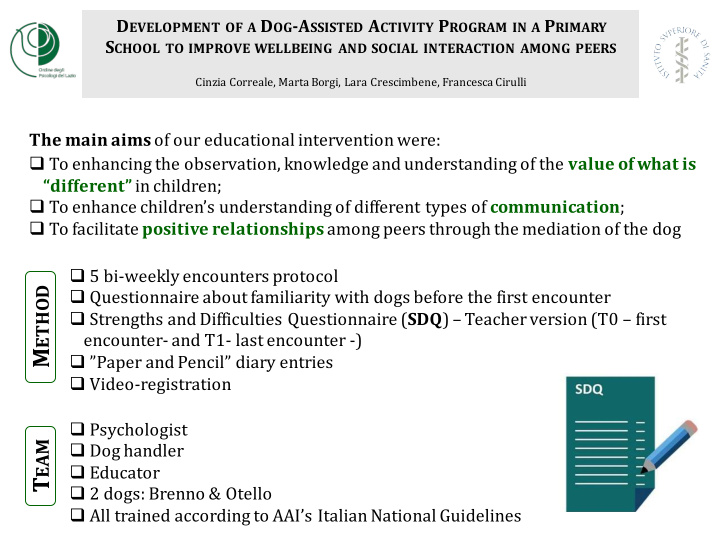



D EVELOPMENT OF A D OG -A SSISTED A CTIVITY P ROGRAM IN A P RIMARY S CHOOL TO IMPROVE WELLBEING AND SOCIAL INTERACTION AMONG PEERS Cinzia Correale, Marta Borgi, Lara Crescimbene, Francesca Cirulli The main aims of our educational intervention were: q To enhancing the observation, knowledge and understanding of the value of what is “different” in children; q To enhance children’s understanding of different types of communication ; q To facilitate positive relationships among peers through the mediation of the dog q 5 bi-weekly encounters protocol M ETHOD q Questionnaire about familiarity with dogs before the first encounter q Strengths and Difficulties Questionnaire ( SDQ ) – Teacher version (T0 – first encounter- and T1- last encounter -) q ”Paper and Pencil” diary entries q Video-registration q Psychologist T EAM q Dog handler q Educator q 2 dogs: Brenno & Otello q All trained according to AAI’s Italian National Guidelines
Activities proposed during the dog-assisted program . Encounter Goal Activities Group session: watching movies 1st encounter: Observation, knowledge and and images on the topic of “Evolution: from understanding of the value of evolution of the wolf and the wolf to dog” what is "different” domestication of the dog. 2nd encounter: Putting oneself in someone's Playing with dogs: blindfolded “Exploring the shoes, experience a different searching activities by using the world through the point of view sense of smell sense of smell” Use of nonverbal Team work: observation of dog 3rd encounter: communication, understanding behaviors and their categorization “A thousand ways the importance of emotions in (emotional categories: happiness, to communicate” communication sadness, insecurity, etc) Team work: creation of fairy tales Use the dog as a mediator of the 4th encounter: with dogs as main characters relationship with peers to “How to play” (narrative about a conflict to be promote a positive interaction solved) Through the dog, children can experience their own 5th encounter: Team work: drawing T -shirts to be interpretation of the parental “Please, take care given as a goodbye gift to the dogs role and what “taking care of of me!” “Brenno” and “Otello” others” means
R ESULTS AND D ISCUSSION All children rated as having difficulties at T0 (n=3) increased (abnormal) Total Difficulties scores at T1. The use of the SDQ questionnaire appears to have allowed teachers to become more aware of some behavioral problems that had been previously underestimated, as well as specific strengths characterizing some of the children. These observations may represent a first step that might encourage the application of dog-assisted programs to target specific behavioral/relational problems and to promote social integration in educational contexts , informing feasibility in the design of larger studies and suggesting assessment tools (i.e., SDQ). R EFERENCE C ORRESPONDENCE C ORREALE C, C RESCIMBENE L, B ORGI M, C IRULLI F (2017) D R . C INZIA C ORREALE – O RDINE DEGLI P SICOLOGI DEL L AZIO ( ITALY ) D EVELOPMENT OF A D OG -A SSISTED A CTIVITY PROGRAM IN AN networkiaa@ordinepsicologilazio.it ELEMENTARY CLASSROOM . V ET S CI 4(4):62.
Recommend
More recommend